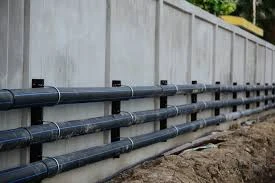Nov . 23, 2024 12:27 Back to list
plumbing pipes and fittings
Understanding Plumbing Pipes and Fittings An Essential Guide
Plumbing is a critical aspect of modern infrastructure, allowing for the efficient movement of water and waste throughout residential and commercial buildings. At the heart of any plumbing system are pipes and fittings, which come in various types, materials, and sizes. Understanding these components is essential for anyone involved in plumbing or even homeowners looking to make informed decisions about their plumbing systems.
Types of Plumbing Pipes
1. PVC Pipes Polyvinyl Chloride (PVC) pipes are lightweight, rigid, and resistant to corrosion and chemicals. They are commonly used for water supply lines and drainage systems due to their affordability and ease of installation. However, PVC pipes are not suitable for hot water applications, as they can warp or soften at high temperatures.
2. CPVC Pipes Chlorinated Polyvinyl Chloride (CPVC) pipes are similar to PVC but can withstand higher temperatures, making them suitable for hot water plumbing. CPVC is also resistant to corrosion and is often used in residential hot water supply systems.
3. PEX Pipes Cross-linked Polyethylene (PEX) is a flexible piping material that has gained popularity in recent years. It is easy to install due to its bendable nature and can expand, making it resistant to freezing. PEX is suitable for both hot and cold water systems, and its flexibility reduces the number of fittings needed, which can lead to fewer potential leak points.
4. Copper Pipes Copper has been a traditional choice for plumbing for many years. It is durable, has natural antimicrobial properties, and can handle both hot and cold water. However, copper is more expensive than plastic options and can be prone to corrosion over time, especially in areas with acidic water.
5. Galvanized Steel Pipes Once a common choice for water supply lines, galvanized pipes are coated with zinc to prevent rusting. However, they are heavy and prone to corrosion, which can lead to reduced water flow over time. Their use has significantly declined in modern plumbing.
Plumbing Fittings
plumbing pipes and fittings

Fittings are essential components that connect various lengths of pipes, allowing for changes in direction, size, and flow. Here are some common types of plumbing fittings
1. Elbows These fittings allow for a change in direction, typically at a 90-degree or 45-degree angle. They are used when pipes need to turn corners.
2. Tees A tee fitting is shaped like the letter T and allows for the branching of pipes into different directions. They can be used to connect three sections of pipe, enabling water flow from two sources.
3. Couplings Couplings are used to connect two sections of pipe linearly. They can be either slip couplings, which are slid over the ends of the pipes, or threaded couplings, which screw onto pipes with threaded ends.
4. Adapters These employ different threads or materials and are used to connect dissimilar pipes. For example, a PVC to copper adapter would enable connection between a plastic and metal pipe.
5. Caps and Plugs Caps are used to close the end of a pipe, while plugs are used for the same purpose but in threaded pipes. These fittings are essential for terminating pipe runs or for testing the system.
Conclusion
In summary, understanding plumbing pipes and fittings is critical for effective plumbing installation and maintenance. The choice between different types of pipes—PVC, CPVC, PEX, copper, and galvanized steel—depends on factors such as application, budget, and local plumbing codes. Additionally, having a grasp of various fittings can help ensure that plumbing systems are set up correctly, minimizing the risk of leaks and ensuring optimal water flow. Whether for DIY projects or professional installations, a solid understanding of these components will contribute to an efficient and reliable plumbing system.
-
High-Quality PPR Pipes and Fittings Durable ERA PPR & PVC PPR Solutions
NewsJul.08,2025
-
Black HDPE Cutting Board - Durable, Non-Porous & Food Safe HDPE Plastic Cutting Board
NewsJul.08,2025
-
High-Quality CPVC Panel Durable HDPE & PVC Panels Supplier
NewsJul.08,2025
-
Double PE Welding Rod Supplier - High Strength, Durable & Versatile Welding Solutions
NewsJul.07,2025
-
High-Quality PVC-O Pipe Supplier Durable 75mm PVC Pipe & Connections Leading PVC Pipe Company
NewsJul.07,2025
-
HDPE Drainage Pipe Supplier – Durable & Corrosion-Resistant Solutions
NewsJul.06,2025

